To ferment vegetables in a salt crock, you'll need unrefined salt, fresh vegetables, and a clean ceramic crock with weights. Start by chopping your vegetables and mixing them with 2-2.5% salt by weight (3-4% for cucumbers). Pack the vegetables tightly into the crock, leaving one inch of headspace, and make sure they're fully submerged in their natural brine. Keep your crock at 64-75°F for 2-6 weeks, checking daily for proper fermentation indicated by bubbling and a sour smell. Remove any surface scum and maintain anaerobic conditions throughout the process. The following expert techniques will help you master the art of traditional fermentation.
Understanding Salt Crock Fermentation
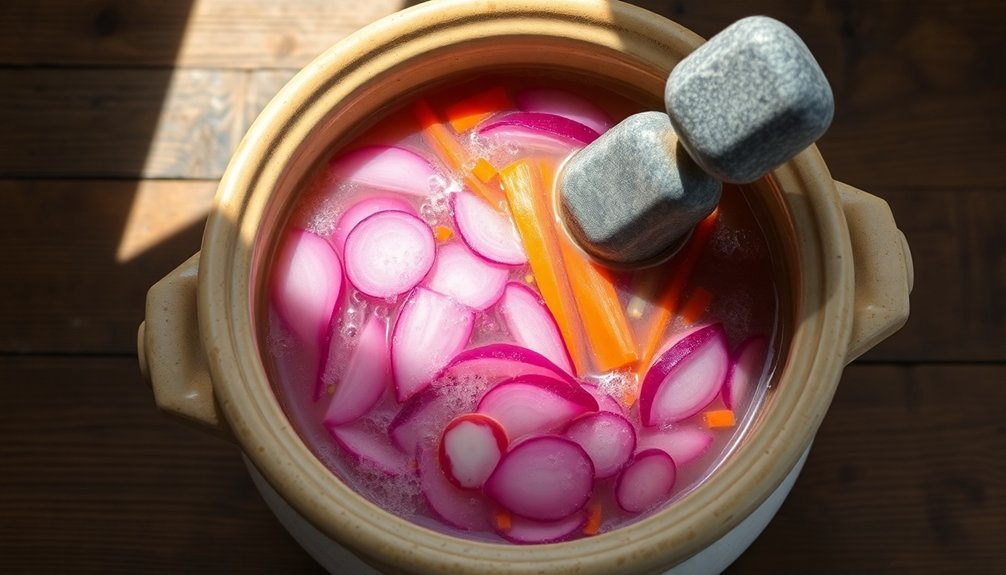
During fermentation, you'll notice bubbling and develop a distinctive sour smell as beneficial bacteria convert the vegetables' natural sugars into lactic acid.
Adding 2% salt content to vegetables is crucial for optimal fermentation results.
You'll need to monitor the process regularly, ensuring vegetables remain submerged and removing any surface scum.
The fermentation period typically lasts 2-6 weeks, depending on your desired flavor intensity and room temperature.
Selecting Vegetables and Salt
Success in vegetable fermentation begins with choosing the right ingredients. You'll want to select a diverse mix of vegetables like cabbage, radish, cauliflower, and turnip, while avoiding store-bought baby carrots that don't ferment well.
Chop, grate, or slice your vegetables to increase surface area and facilitate faster fermentation. Remember to pack them tightly to prevent floating. Always leave one inch headspace at the top of your containers when packing vegetables.
When combining vegetables, pair complementary flavors and textures. Mix crunchy vegetables with softer ones, and add natural spices like ginger, garlic, or herbs such as caraway and oregano.
Keep in mind that sugar-rich vegetables like beets and carrots work better in a mix rather than fermenting alone.
For salt selection, you'll need unrefined options like sea salt, Himalayan salt, or Celtic sea salt. These contain beneficial minerals that support fermentation.
Avoid iodized salt, as it inhibits beneficial bacteria. Maintain a salt concentration between 2-5% for most vegetables, though cucumbers and squash need 3-4%, while garlic and beetroot can ferment with 2%.
Remember that salt quality matters – choose options free from anti-caking agents and other additives that could interfere with fermentation.
Preparing Your Fermentation Setup
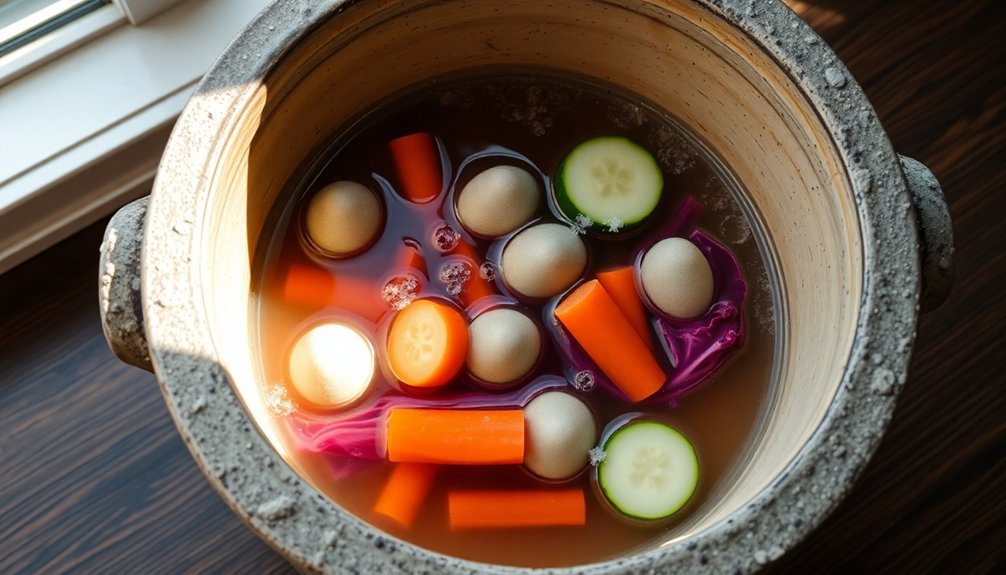
Properly setting up your fermentation vessel is essential for achieving safe, delicious results. Start by selecting a clean glass jar or ceramic crock with a wide mouth, and wash it thoroughly to remove any contaminants. If you're using a ceramic crock, make certain it has a water seal or airlock system to prevent unwanted air from entering. For optimal results, maintain a temperature of 65-75°F during the fermentation process.
Pack your prepared vegetables tightly into the vessel, leaving about an inch of headspace at the top. You'll need to keep everything submerged, so add fermentation weights or springs to hold the vegetables down.
Mix your brine by stirring salt into room-temperature filtered water until it's completely dissolved. Don't use tap water, as the chlorine can interfere with fermentation.
Pour the brine over your vegetables until they're fully covered, maintaining a half-inch space above the liquid for gas expansion. Cover your vessel with an airlock lid or valved cap to let gases escape while keeping oxygen out. If you're using a regular lid, you'll need to "burp" it daily.
Place your setup in a warm, dark spot and monitor the fermentation by tasting every few days until you achieve your desired flavor.
Salt Ratios and Measurements
Now that your fermentation vessel is set up, getting the salt concentration right makes all the difference in your final product. For most vegetables, you'll want to aim for a 2-2.5% salt concentration, though some produce requires different amounts. Cucumbers and peppers need 3-4% salt, while olives demand up to 10%.
To achieve precise measurements, you'll need to use a kitchen scale rather than volume measurements. Calculate the total weight of your vegetables and water combined, then multiply that number by the desired salt percentage. For example, if you've got 1000g of vegetables and water, you'll need 25g of salt for a 2.5% concentration.
When preparing a brine, calculate based on water volume – 1 liter of water needs 25g of salt for a 2.5% solution.
Make certain you're using the right concentration for your vegetables: lower salt levels (1-2%) speed up fermentation but may reduce preservation time, while higher levels (3-4%) slow fermentation but help vegetables stay crunchy longer.
Whatever concentration you choose, make certain all vegetables remain completely submerged in the brine to prevent mold growth.
Proper Brine Techniques
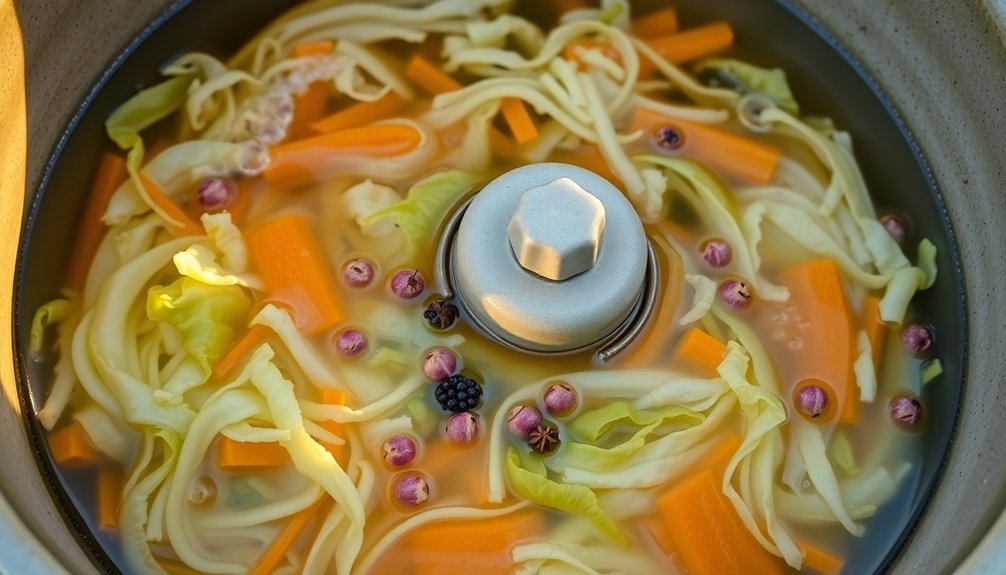
The foundation of vegetable fermentation lies in mastering proper brine techniques. Start by mixing salt with distilled or filtered water, guaranteeing your salt is free from additives and iodine that could interfere with fermentation. Let the brine cool completely if you've used boiled water to prevent premature vegetable spoilage.
When you're ready to ferment, pack your vegetables tightly in the crock, leaving 1-2 inches of headspace. Pour the brine over them until they're completely submerged, then use a weight or fermentation spring to keep everything below the surface.
To maintain a successful ferment, you'll need to:
- Check the brine level daily to guarantee vegetables remain submerged
- Remove any trapped air bubbles using a thin spatula
- Burp the jars daily if you're not using an airlock lid
- Monitor for signs of mold or unusual odors
- Keep the fermentation area clean and away from direct sunlight
Use a clean plate weighted with brine-filled bags or jars to maintain submersion. Cover the crock with a clean, heavy towel or lid to prevent contamination.
Once your vegetables reach the desired sourness, transfer them to the refrigerator to slow fermentation.
Managing the Fermentation Process
Successfully managing your fermentation process requires careful attention to several key factors that work together to create the perfect environment for beneficial bacteria.
You'll need to maintain strict anaerobic conditions by keeping your vegetables fully submerged in brine and removing any air bubbles that form during packing.
Monitor your salt concentration carefully, as different vegetables require specific ratios. While most vegetables do well with a 2.5% salt-to-water solution, you'll want to increase this to 3.5-5% for cucumbers and up to 10% for olives. Use a kitchen scale to guarantee accuracy in your measurements.
Proper weight distribution is essential for successful fermentation. Pack your vegetables tightly in the crock and use a tamper to compress them. You'll need to check regularly that your fermentation weights are keeping everything submerged beneath the brine.
Keep your fermentation area at a stable temperature between 64°F and 75°F. Your fermentation time will vary depending on the vegetables and desired outcome, ranging from a few days to several weeks.
You can slow down fermentation by using higher salt concentrations, or speed it up with lower salt levels – just remember to monitor more frequently with low-salt methods.
Troubleshooting Common Issues
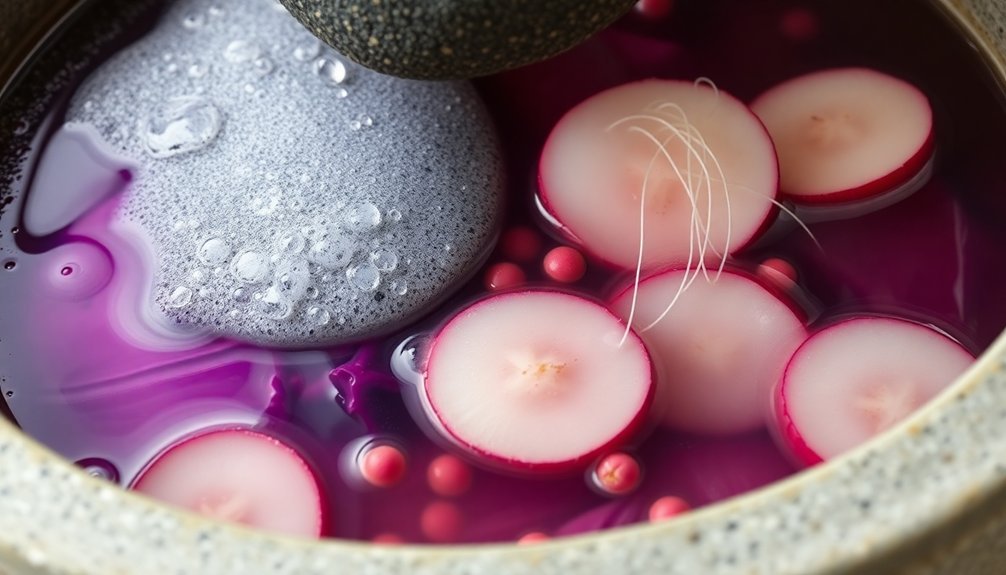
When you're fermenting vegetables in a salt crock, you'll need to watch for common issues like surface mold, which you can prevent by ensuring proper submersion and maintaining clean conditions throughout the process.
You'll also want to measure your salt carefully to achieve the right balance – too little can lead to spoilage while too much will slow fermentation and create an overly salty product.
Keep in mind that some vegetables may change in texture or color during fermentation, but these changes are usually normal as long as you've followed proper salt ratios and temperature guidelines.
Mold Prevention Strategies
Preventing mold in your fermented vegetables requires a systematic approach focused on four key areas: proper submersion, hygiene, environmental control, and regular monitoring.
Keep your vegetables completely submerged under the brine by using fermentation weights or clean rocks. Pack them tightly to eliminate air pockets, and secure floating pieces with larger chunks of produce.
You'll need to maintain strict hygiene standards by washing your hands and equipment thoroughly before handling the ferment.
Control your fermentation environment by keeping the temperature between 65° and 80°F, ideally around 72°F. Use an airtight vessel or one with an airlock lid to minimize oxygen exposure, and keep your ferment away from direct sunlight and drafts.
To effectively prevent mold growth, follow these essential practices:
- Clean and inspect vegetables carefully before fermentation
- Pack vegetables densely to eliminate air pockets
- Monitor brine levels daily and adjust as needed
- Keep fermentation vessels away from heat sources
- Check regularly for signs of kahm yeast or mold formation
If you spot any mold, quickly remove it along with any affected vegetables.
Remember that white kahm yeast isn't harmful, but colored or fuzzy growth indicates true mold that requires immediate attention.
Maintaining Proper Salt Balance
At the heart of vegetable fermentation lies proper salt balance, which serves as both a preservative and flavor enhancer. You'll want to maintain salt concentrations between 1% and 15%, depending on your vegetable type. For sauerkraut, aim for 2.25-2.5%, while pickles need 3-5% for low-salt variants or 5-16% for high-salt versions.
If you notice your fermentation isn't progressing as expected, check your salt levels. Too much salt will slow down fermentation, while too little (below 1%) can lead to mold growth and spoilage. You can fix an overly salty brine by adding more vegetables or water, but remember to maintain proper ratios.
Choose your salt carefully – avoid iodized table salt and anti-caking agents, as they'll cloud your brine and potentially interfere with fermentation. Instead, use unrefined sea salt or natural mineral salt.
When preparing your brine, calculate salt based on the total weight of vegetables and water. Always use filtered or distilled water to avoid chlorine interference, and keep your vegetables fully submerged.
Monitor your fermentation regularly, adjusting salt concentrations if needed to maintain ideal conditions.
Texture and Color Changes
During fermentation, your vegetables will undergo natural changes in both texture and color that can signal either proper development or potential issues. You'll want to monitor these changes closely to guarantee your ferment stays healthy and delicious.
To maintain ideal texture, keep your vegetables fully submerged in brine and packed tightly to eliminate air pockets. If you notice mushiness developing, it's often due to excess oxygen or insufficient salt. Don't use whey as a starter; instead, rely on natural fermentation or a specialized veggie starter culture.
Watch for these color changes that indicate potential problems:
- Green, blue, or black mold growth requires immediate disposal
- White or grey film on top is likely Kahm yeast, which you can skim off
- Darkening at the brine surface is normal oxidation
- Pink discoloration may signal unwanted yeast growth
- Brown vegetables could indicate over-fermentation
For the crunchiest results, use the right amount of mineral-rich salt, maintain a temperature around 72°F, and avoid over-handling the vegetables.
If your ferment becomes too dry, simply add more brine solution (1 teaspoon salt per 1/2 cup water) until vegetables are completely covered.
Storage and Long Term Care
Successful long-term storage of your fermented vegetables depends heavily on maintaining proper environmental conditions.
You'll want to keep your ferments in a cool, dark place with temperatures just above 32°F (0°C), making your refrigerator an ideal storage location. Avoid exposing your ferments to direct sunlight, as UV rays can kill the beneficial bacteria you've worked so hard to cultivate.
For best storage, you'll need to maintain proper container conditions. If you're using a traditional crock, cover it with a flat lid or cloth that allows gases to escape while keeping unwanted bacteria out.
Water-seal crocks require regular checks to verify the water seal remains intact. Keep your vegetables submerged under the brine by monitoring levels daily during initial fermentation.
Your fermented vegetables can last up to nine months when properly stored in refrigerated conditions. While quality may decline after this period, they're often still safe to eat thanks to the acidic environment created by proper salt fermentation.
Check regularly for mold and remove any surface scum that develops. Remember to clean the plate and crock rim frequently to prevent contamination.
Frequently Asked Questions
Can I Reuse the Brine From a Previous Batch for New Ferments?
Yes, you can reuse brine from previous ferments as a starter culture. It'll speed up fermentation since it's already rich in beneficial bacteria. Just make sure your original brine was made with a starter or kefir whey.
What Materials Should Fermentation Weights Be Made From for Safety?
You'll want to use glass fermentation weights for ideal safety. They're non-porous, easy to sterilize, and won't absorb flavors. Avoid ceramic weights, which can harbor bacteria, and never use untested inorganic materials.
How Do Seasonal Temperature Changes Affect Fermentation Time and Salt Ratios?
You'll need more time to ferment in winter due to slower bacterial activity, while summer's warmth speeds things up. You don't have to change salt ratios, but adding extra salt in summer helps control faster fermentation.
Can I Mix Different Vegetables in the Same Fermentation Crock?
Yes, you can mix different vegetables together. Combine compatible options like cabbage, radish, cauliflower, and turnips. Just make sure you chop them similarly and maintain the same 2% salt ratio for the mix.
What Causes Vegetables to Turn Mushy Instead of Staying Crisp?
Your vegetables can turn mushy if you're using too little salt, fermenting too long, letting them float above the brine, or storing at incorrect temperatures. These factors break down cell structure and ruin crispness.
In Summary
Now that you've mastered salt crock fermentation, you're ready to create delicious, probiotic-rich vegetables at home. Don't forget to monitor your ferments daily, adjust salt levels as needed, and trust your senses when checking for doneness. Keep experimenting with different vegetables and combinations to develop your own signature ferments. With proper care, your salt crock will provide years of successful fermentation projects.

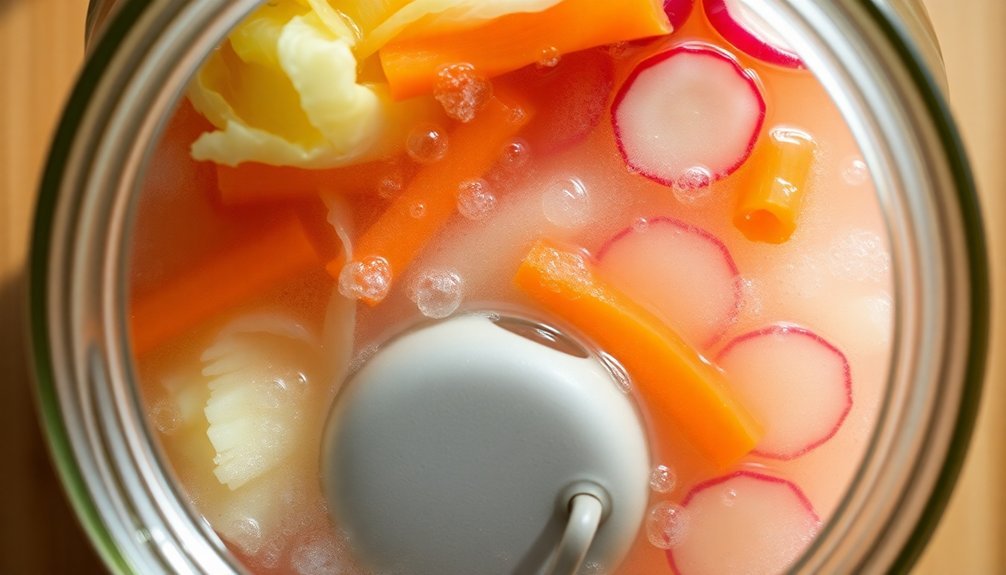



Leave a Reply